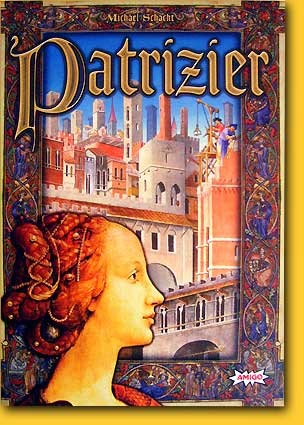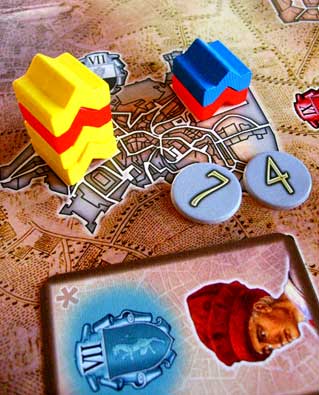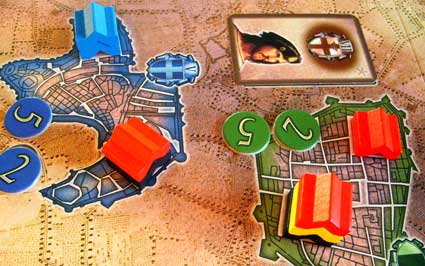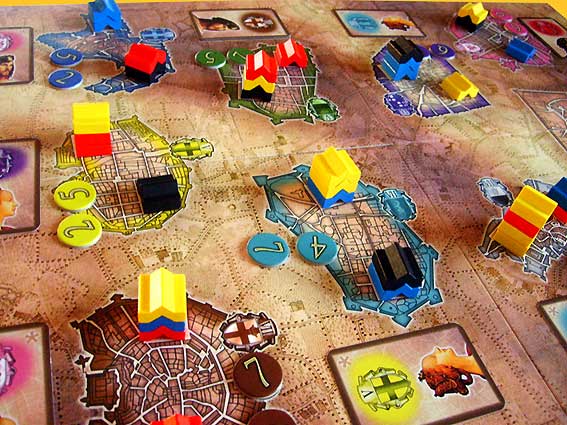Patrizier / Patrician
Author: Michael Schacht
Publisher: Amigo
Year: 2007
review by

| x |
|
|
|
|
|
|
|
|
|
|
|
|
|
|
|
|
|
|
|
|
|
|
|
|
|
|
|
|
|
|
|
|
|
|
|
|
|
|
|
|
|
|
|
|
|
 |
This time we are master builders; hired to build impressive towers around the buildings of rich patrician families in Italy during the Middle Ages. At the same time, the portraits of these families should be collected, as if they were baseball cards. Thematically a bit strange, but surely no obstacle for the two to five players.
The double sided board shows nine Italian cities on one side, each in its own colour; the other side is for five players only and has one additional city. |
|
|
| x |
|
|
|
|
|
|
|
|
|
|
|
|
|
|
|
|
|
|
|
|
|
|
|
|
|
|
|
|
|
|
|
|
|
|
|
|
|
|
|
|
|
|
|
|
|
 |
| x |
|
|
|
|
|
|
|
|
|
|
|
|
|
|
|
|
|
|
|
|
|
|
|
|
|
|
|
|
|
|
|
|
|
|
|
|
|
|
|
|
|
|
|
|
|
|
Each city has two sites for building a tower. Contrary to what might be believed from the Italians, building is strictly regulated: for each city a maximum of floors is prescribed. In Milan, for example, nine floors are allowed, divided between the two building sites. The players are responsible for building the towers; for this purpose they have a number of wooden floors in their player’s colour at their disposal.
|
|
|
|
 |
|
| x |
|
|
|
|
|
|
|
|
|
|
|
|
|
|
|
|
|
|
|
|
|
|
|
|
|
|
|
|
|
|
|
|
|
|
|
|
|
|
|
|
|
|
|
|
|
 |
x |
In a player’s turn one, sometimes two, floors are added to a tower in a city by playing a card. As soon as a city is has the maximum amount of floors built, it is scored immediately: the player who built the most floors in the tallest tower scores the highest number of points indicated by the two tokens placed next to the city at the start of the game. The player who built the most floors in the lower tower takes the token with the lesser points. Since an odd number of floors is built, towers of equal height can never occur. As soon as all cities are scored, the game ends.
|
|
| x |
|
|
|
|
|
|
|
|
|
|
|
|
|
|
|
|
|
|
|
|
|
|
|
|
|
|
|
|
|
|
|
|
|
|
|
|
|
|
|
|
|
|
|
|
|
|
At the start of the game each player is dealt three cards. Also, a card is placed face up next to each city. Each card shows the crest and colour of a city, with sometimes symbols for special actions, or a portrait of a Patrician family, or a second city in the same colour. The symbols can either be a question mark, or a ‘floor transfer’ symbol.
In a turn, a player plays one of his three cards, which he places on a personal stack in front of him. This card shows the city where there will be built: usually one floor, sometimes two when the card showed two city crests. Then the player takes as a replacement card the card located next to the city where he just built, and a new card is drawn from the pile and placed next to the city. When applicable, the special action can be executed. With the question mark any card from the board may be taken as a replacement. Using the ‘transfer action’, the player can choose a city where he has built before –but excluding the one where he just built- and in that city move the top floor from one tower to the other; a teasing action to change the odds in one’s own advantage.
|
|
|
| x |
|
|
|
|
|
|
|
|
|
|
|
|
|
|
|
|
|
|
|
|
|
|
|
|
|
|
|
|
|
|
|
|
|
|
|
|
|
|
|
|
|
|
|
|
|
|
|
|
The players repeat their actions clockwise until all cards are played and all cities are finished and scored. The portraits on the cards in the player’s card pile only now have their effect as bonus victory points: each set of three matching portraits gets a player six points. At the end of the game each player counts his points on his city tokens and add his bonus points for the portraits; the player with the highest total wins the game. |
|
| x |
|
|
|
|
|
|
|
|
|
|
|
|
|
|
|
|
|
|
|
|
|
|
|
|
|
|
|
|
|
|
|
|
|
|
|
|
|
|
|
|
|
|
|
|
|
| x |
|
|
|
|
|
|
|
|
|
|
|
|
|
|
|
|
|
|
|
|
|
|
|
|
|
|
|
|
|
|
|
|
|
|
|
|
|
|
|
|
|
|
|
|
|
 |
|
|
|
|
|
|
|
|
|
|
|
|
|
|
|
|
|
|
|
|
|
|
|
|
|
|
|
|
|
|
|
|
|
|
|
|
|
|
|
|
|
|
What sticks out already during the first game, is the speed of playing. A game of ‘Patrizier’/’Patrician’ usually does not take more than twenty to thirty minutes. This is largely due to the limited amount of possible actions a player has each turn: just three. The choice for playing a certain card is determined by the current building status of the corresponding city and the card lying face up next to it. This new card will hopefully give a player new options for a next turn. Play a card (build) for a city, possibly execute a special action, take the replacement card and draw a new card for the city, and it’s the next player’s turn already!
|
x |
x |
 |
| x |
|
|
|
|
|
|
|
|
|
|
|
|
|
|
|
|
|
|
|
|
|
|
|
|
|
|
|
|
|
|
|
|
|
|
|
|
|
|
|
|
|
|
|
|
|
 |
x |
Given the limited options for planning, ‘Patrizier’/’Patrician’ falls into the category of ‘light tactical’ games. Something for ‘in between’, but that does not mean in any way it is a bad game. It is nice to build and stack the wooden floors, and it remains thrilling who will be able to finish and score these final towers. With two players there is some room for planning, but the players are still dependent on the luck of the card draw. With five players it starts to be become all quite random, but for such a short game this may not be real problem. Graphically it all looks quite nice, but take care of good lighting above the table to be able to distinguish all ten city colours and five player colours! After playing, the boards looks very nice and photogenic with all the differently coloured towers.
|
| x |
|
|
|
|
|
|
|
|
|
|
|
|
|
|
|
|
|
|
|
|
|
|
|
|
|
|
|
|
|
|
|
|
|
|
|
|
|
|
|
|
|
|
|
|
|
‘Patrizier’/’Patrician’ may not be a ‘must-have’, but it certainly is a ‘nice-to-have’, this majority game by Michael Schacht. To be consumed as a starter before a main course or as a snack in between during a game gathering!
© 2007 Edwin van de Sluis
Patrizier, Michael Schacht, Amigo, 2007 - 2 to 4 players, 10 years and up, 60 minutes
|
  |
|
|
|
|
|
|
|
|
|
|
|
|
|
|
|
|
|
|
|
|
|
|
|
|
|
|
|
|
|
|
|
|
|
|
|
|
|
|
  |
|
|
|
|
|
|
|
|
|
|
|
|
|
|
|
|
|
|
|
|
|
|
|
|
|
|
|
|
|
|
|
|
|
|
|
|
|
|
|
|
|
  xxxHardly original after 'Manhattan' and 'Capitol', both being better games xxxHardly original after 'Manhattan' and 'Capitol', both being better games |
  |
|
|
|
|
|
|
|
|
|
|
|
|
|
|
|
|
|
|
|
|
|
|
|
|
|
|
|
|
|
|
|
|
|
|
|
|
|
|
|
|
|
  |
|
|
|
|
|
|
|
|
|
|
|
|
|
|
|
|
|
|
|
|
|
|
|
|
|
|
|
|
|
|
|
|
|
|
|
|
|
|
|
|
|
  |
|
|
|
|
|
|
|
|
|
|
|
|
|
|
|
|
|
|
|
|
|
|
|
|
|
|
|
|
|
|
|
|
|
|
|
|
|
|
|
|
|
| x |
|
|
|
|
|
|
|
|
|
|
|
|
|
|
|
|
|
|
|
|
|
|
|
|
|
|
|
|
|
|
|
|
|
|
|
|
|
|
|
|
|
|
|
|
|
| x |
|
|
|
|
|
|
|
|
|
|
|
|
|
|
|
|
|
|
|
|
|
|
|
|
|
|
|
|
|
|
|
|
|
|
|
|
|
|
|
|
|
|
|
|
|
 |
|
|
|
|
|
|
|
|
|
|
|
|
|
|
|
|
|
|
|
|
|
|
|
|
|
|
|
|
|
|
|
|
|
|
|
|
|
|
|
|
|
 |
|
|
|
|
|
|
|
|
|
|
|
|
|
|
|
|
|
|
|
|
|
|
|
|
|
|
|
|
|
|
|
|
|
|
|
|
|
|
|
|
|
| x |
|
|
|
|
|
|
|
|
|
|
|
|
|
|
|
|
|
|
|
|
|
|
|
|
|
|
|
|
|
|
|
|
|
|
|
|
|
|
|
|
|
|
|
|
|
 |
|
|
|
|
|
|
|
|
|
|
|
|
|
|
|
|
|
|
|
|
|
|
|
|
|
|
|
|
|
|
|
|
|
 |
|
|
|
|
|
|
|
|
|
|
|
|
|
|
|
|
|
|
|
|
|
|
|
|
|
|
|
|
|
|
|
|
|
|
|